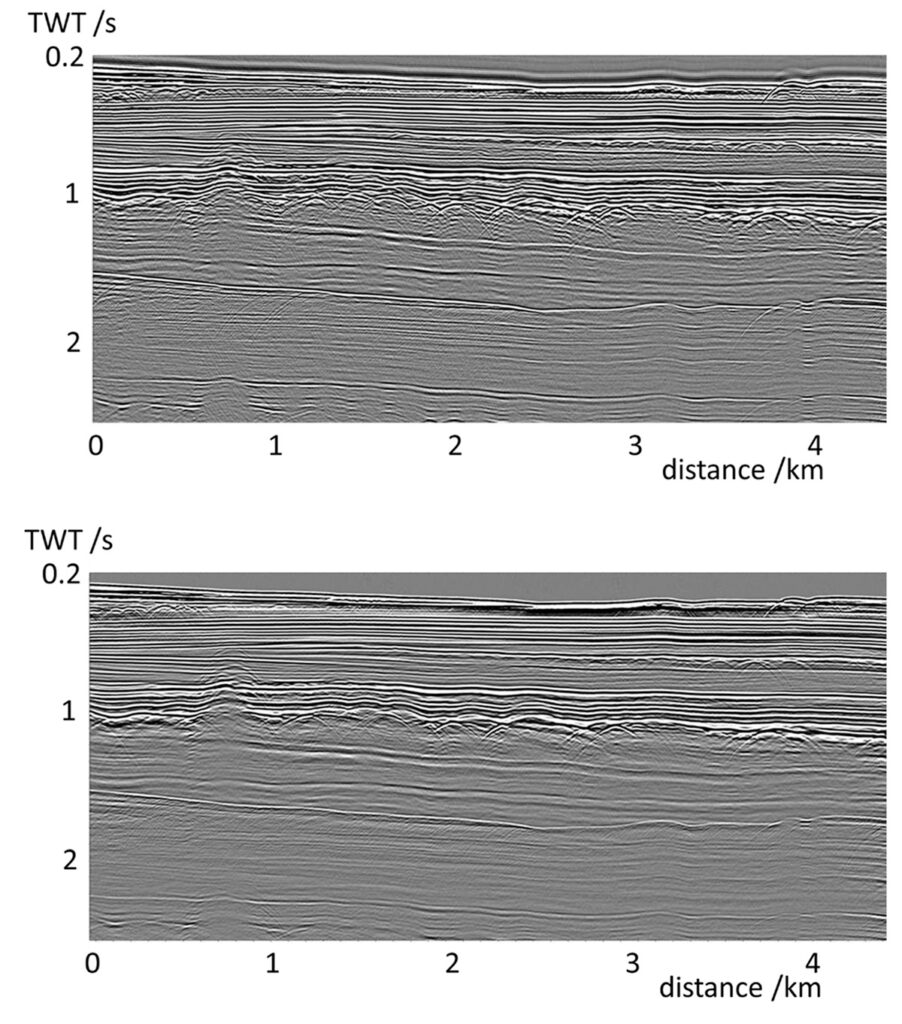Marine Vibroseis
Marine vibroseis (marine vibrators) is a technique for creating a geophysical survey sound source by displacing a volume of water with a vibrating plate or shell to create a pressure wave. This technique is an alternative method to the traditional seismic airgun array used for geophysical surveys. Seismic airguns have the potential to cause injury, hearing loss, behavioral changes, and masking in fishes, marine mammals, and possibly even many invertebrates (see the Sound Source > Seismic Airgun page for more information). Marine vibroseis surveys generally have less potential to impact marine animals than airgun surveys.

Seismic airguns produce an impulsive signal, or a short duration, high amplitude signal. In contrast, marine vibroseis produces a long duration, low amplitude signal and operates at a lower peak intensity. The output frequencies produced by marine vibroseis are generally 2 Hz to 100 Hz and can be controlled, resulting in less unwanted sound outside the target frequencies. The output signal from marine vibroseis may be tonal or sweeping, depending on the application and specific device. Because of the good control over output frequencies and phase generated by marine vibroseis, it can theoretically be more efficient than airgun surveys. Signal duration is typically 5 seconds up to 40 seconds depending on the device and application. There is usually only a short time period, one or two seconds, between signals to maximize efficiency.
Several studies have compared geophysical results from seismic airguns with those from marine vibroseis. One study surveyed the same location in the North Sea with both a small airgun array and marine vibroseis as a field test and found the seismic image produced by marine vibroseis is comparable to the airgun image. A second study (images below) found that the marine vibroseis survey of an area could be completed in one-third of the time needed for a seismic airgun survey.

DOSITS Links
- Technology Gallery > Airgun Technology
- Sound Sources > Seismic Airgun
- Audio Gallery > Airgun
- People > How is sound used to study the Earth’s history?
- Technology Gallery > Sub-bottom Profiler
Additional Resources
- GEOExPRO Magazine: Geophysical Technology: Marine Vibrators
References
- Duncan, A. J., Weilgart, L. S., Leaper, R., Jasny, M., & Livermore, S. (2017). A modelling comparison between received sound levels produced by a marine Vibroseis array and those from an airgun array for some typical seismic survey scenarios. Marine Pollution Bulletin, 119(1), 277–288. https://doi.org/10.1016/j.marpolbul.2017.04.001
- Feltham, A., Girard, M., Jenkerson, M., Nechayuk, V., Griswold, S., Henderson, N., & Johnson, G. (2018). The Marine Vibrator Joint Industry Project: Four years on. Exploration Geophysics, 49(5), 675–687. https://doi.org/10.1071/EG17093
- Laws, R. M., Halliday, D., Hopperstad, J. ‐F., Gerez, D., Supawala, M., Özbek, A., Murray, T., & Kragh, E. (2019). Marine vibrators: The new phase of seismic exploration. Geophysical Prospecting, 67(6), 1443–1471. https://doi.org/10.1111/1365-2478.12708
- Matthews, M.-N. R., Ireland, D. S., Zeddies, D. G., Brune, R. H., & Pyć, C. D. (2020). A Modeling Comparison of the Potential Effects on Marine Mammals from Sounds Produced by Marine Vibroseis and Air Gun Seismic Sources. Journal of Marine Science and Engineering, 9(1), 12. https://doi.org/10.3390/jmse9010012
- Mougenot, D. (2018). Marine, seabed, and land seismic equipment for broadband acquisition: A review: Seismic equipment for broadband acquisition. Geophysical Prospecting, 66(5), 922–933. https://doi.org/10.1111/1365-2478.12537
- Teyssandier, B., & Sallas, J. J. (2019). The shape of things to come—Development and testing of a new marine vibrator source. The Leading Edge, 38(9), 680–690. https://doi.org/10.1190/tle38090680.1